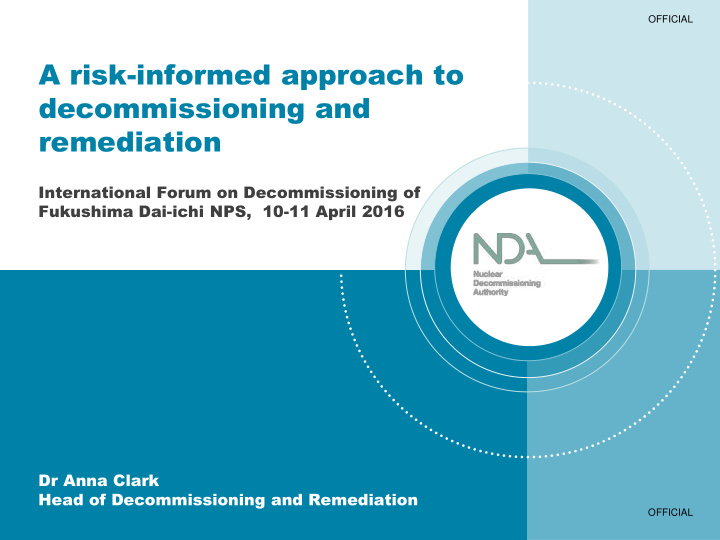



OFFICIAL A risk-informed approach to decommissioning and remediation International Forum on Decommissioning of Fukushima Dai-ichi NPS, 10-11 April 2016 Dr Anna Clark Head of Decommissioning and Remediation OFFICIAL
OFFICIAL UK civil nuclear legacy Dounreay Sellafield Magnox power reactors Research reactors OFFICIAL
OFFICIAL Prioritisation and the Value Framework • Priority of a decommissioning and remediation project depends on the risk it is addressing and the value it delivers • Value Framework allows us to compare value of different options Risk to human health during decommissioning Health and Safety Risk / hazard reduction Risk to human health once decommissioning is complete Impact on security of materials and associated records Security Impact of discharges and activities on environment Environment Use of raw materials including water and energy Impact on employment, infrastructure and wellbeing of Socioeconomic impact community Lifecycle cost (capital cost, maintenance cost) and return Finance on spend Impact on delivery of wider mission, e.g . setting Enabling the mission precedents, building capability, testing technologies www.gov.uk/government/publications/nda-value-framework-how-we-make-decisions OFFICIAL
OFFICIAL Risk to people and environment • Prioritisation influenced strongly by level of risk to people and environment: – “Where risks are intolerable we will take urgent action to reduce them” – “We will act proportionately to ensure that the net level of risk does not increase in the long term” – “Where the risk is less significant, prioritisation takes greater account of other factors in our Value Framework ” OFFICIAL
OFFICIAL Safety and Environmental Detriment • Safety and Environmental Detriment (SED) measure was developed to allow comparison of hazard posed by facilities across entire NDA estate • The NDA is delighted to be working with the NDF and TEPCO to modify the SED measure to suit Fukushima Dai-ichi OFFICIAL
OFFICIAL Risk profiles and informing prioritisation • Prioritisation is informed by: – Level of risk at a point in time – Profile of risk versus time Priority 1? Intolerable Level of risk Tolerable Priority 2? Broadly acceptable Time OFFICIAL
OFFICIAL Demonstrating the ‘value’ of action • Understanding the ‘value’ of different actions informs decision -making Action 1 Intolerable Level of risk ‘Value’ of Action 1 Action 2 Tolerable ‘Value’ of Action 2 Broadly acceptable Time OFFICIAL
OFFICIAL Demonstrating ‘value’ of interim solutions • May choose to deliver a project that offers less risk reduction because it reduces the time at risk – “Where risks are intolerable we will take urgent action to reduce them” Action 1 Action 2 Intolerable Level of risk Tolerable Reducing time at risk Broadly acceptable Time OFFICIAL
OFFICIAL Demonstrating Value for Money • Does the ‘value’ of an action justify the impact on other elements of the Value Framework (impact on environment, finance, etc. )? Intolerable Action Level of risk ‘Value’ of Action Tolerable Broadly acceptable Time OFFICIAL
OFFICIAL Pace of decommissioning Constraints on implementation might be associated with: Value Framework • Resources • Logistics • Technology • Policy, strategy and legislation Priorities Pace Constraints • Stakeholder confidence Implementation Plan OFFICIAL
OFFICIAL Value takes many forms • When risks are tolerable or broadly acceptable, there are other reasons for progressing with decommissioning OFFICIAL
OFFICIAL How to find out more Our website: www.gov.uk/nda Subscribe to receive: • E-bulletin • Blog post notifications: nda.blog.gov.uk Follow us on: • Twitter @NDAgovuk • LinkedIn Join 700+ members in: NDA Estate Supply Chain LinkedIn Group OFFICIAL
Recommend
More recommend